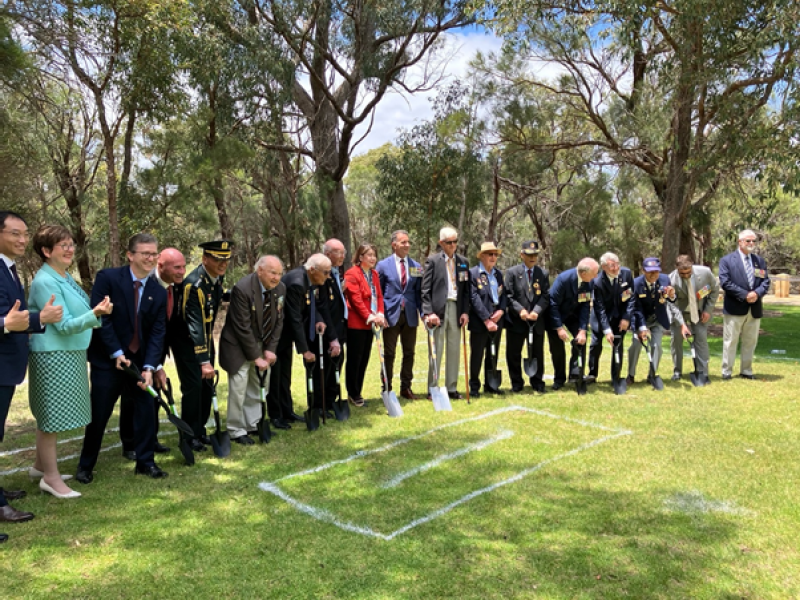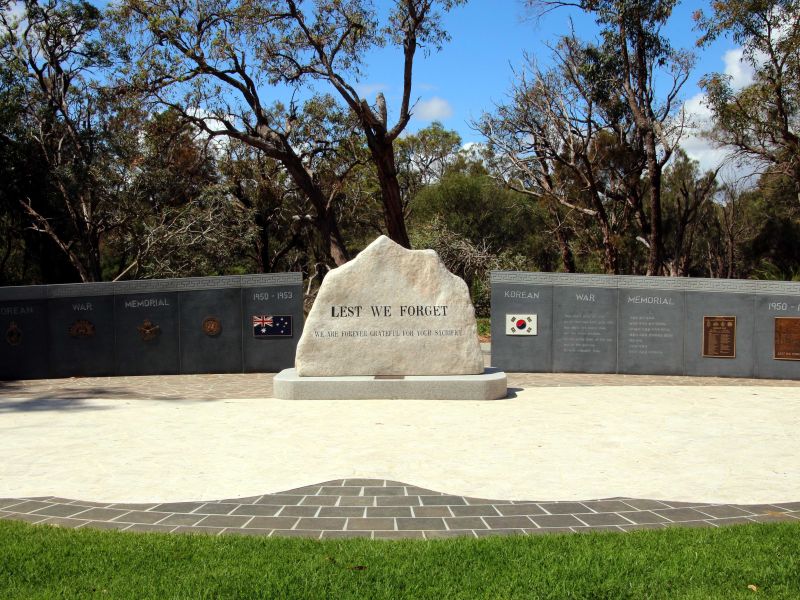The Korean War Memorial Kings Park
In 2016, the Honorary Consul in Western Australia to the Republic of Korea, Mrs Fay Duda, was approached by a veteran at the North Beach RSL, who asked: “Why isn’t there a Korean Memorial in Perth?” This was followed by a similar request from the Korean Veterans’ Association president, Mr Jin Kil Lee. This set the process in motion to ensure the Korean War, in Perth, was not the “Forgotten War”.
The Korean War was called the “Forgotten War” because it broke out in the aftermath years following WWII; and not long before the Vietnam conflict. Technically, it was not a war because the United Nations could not declare war, but the US - at the behest of the UN Security Council, could. Thus, the Korean War commenced on June 25, 1950, and hostilities continued until the Deed of Armistice was signed on July 27, 1953.
The conflict was certainly not forgotten by more than 17,000 Australian and 1,916 West Australians; servicemen and nurses who served in the Korean conflict between 1951 and 1953. It was also not forgotten by the families of the 34 West Australians who died, and those who returned with mental and physical injuries.
Sadly, the Korean War was “forgotten” except for a small memorial plaque in the Rose Garden of the Pinjarra RSL. Memorials existed in other cities in Australia but not in Perth. In 2018, the Honorary Consul approached Highgate RSL with a proposal to build a memorial to Western Australian veterans of the Korean War in Kings Park.
Highgate RSL activities in Kings Park included the Deputy Wardens and Sub-Wardens at the State War Memorial; the Honour Avenues Group responsible for the plaques on May and Lovekin Drives; and the Remembrance Walk App that had recorded the history of existing War Memorials in the Park.
Bill Munro, Highgate’s president at the time, drew together a team of volunteers consisting of Peter Heeney, Duncan Warren, James Lee, Jin Kil Lee and Fay Duda (all members of Highgate); and later Brett Dowsing and Nigel Earnshaw, Clive Robartson from RAAFAWA, Jack Hwang and James Rhee, a prominent Korean Australian businessman.
It was essential to gain the support of RSLWA for the memorial initiative. The Botanic Gardens and Park Authority (BGPA) had placed the authority for all memorials in Kings Park with RSLWA. Without RSLWA, approval the BGPA would have refused the proposal. The Committee received great bipartisan support from Peter Tinley MLA, who was the Minister for Veterans Interests at the time and the Opposition spokesman for Veterans, Tjorn Sibma MLC . This backing ensured BGPA approved the project. The Western Australian Government also contributed $150,000 through ANZAC Day Trust over two years to assist in the construction of the Memorial.
The BGPA, also recommended the Committee employ the services of “Plan E”, landscape architects, the consultants employed in Kings Park development plans. Over the following 18 months, the Committee and Plan E agreed to a final concept plan. The design was a commemorative wall featuring plaques; of badges of the three services; the UN emblem; an Australian and a Korean Flag; the Ode in both English and Korean; an Honour Roll; plus the names of all those West Australians who had served in the Korean War. Additionally, there was to be a detailed bronze map of the Korean Peninsula.
The paving of the base of the memorial contains an illustration of the Korean floral emblem, the Rose of Sharon. This is the national flower of Korea; it represents determination, politeness, and endurance and expresses Koreans’ feelings in the best way.
The BGPA selected the Tobruk Memorial precinct at the corner of Saw Avenue and May Drive as the site for the Korean Memorial. This location includes the Prisoners of War Memorial and the 2/28th Battalion & 24th Anti-Tank Company Memorial. However, the Eastern end of the precinct was made available for the Korean Memorial.
In addition, the BGPA required a community contribution in return for the Board making the land for the memorial available. As a result it was agreed to construct a 2-metre pathway separating the bush from the grassed area of the precinct, as well as a sound shell and pavilion on the other side of May Drive.
After four years of dedicated, tireless work by the Perth Korean War Memorial Committee, construction commenced at the memorial site with a Ground Breaking Ceremony on 2 December 2022.
The highlight of the design came from the work of Jin Kil Lee. One of the most recognised battles of the Korean War was the Battle of Kapyong (or Gapyeong in Korean.) The battle is widely acknowledged in Korea because it was there that the 3rd Battalion Royal Australian Regiment, together with the 2nd Battalion Princess Patricia’s Canadian Light Infantry and supported by 16th Field Regiment of the Royal Regiment of New Zealand Artillery; held back about 6,000 North Korean troops reinforced by Chinese soldiers. The battle was the turning point of the 1951 Spring Offensive. Seoul was not overrun and South Korea went on to become the prosperous trading nation of today.
The Council of the County of Gapyeong has acknowledged the importance of their valley in the Korean War. It has donated over 70 pieces of granite and quartz rock for memorials around the world. Committee member, Jin Kil Lee, conducted negotiations with the Council of Gapyeong. The rock chosen and gifted to the Perth Memorial, replicates the silhouetted skyline view from the floor of the Gapyeong Valley, looking upwards at the mountains against the sky.
The Memorial took eight months to construct and on 27 July 2023, the 70th Anniversary of the Armistice, over 700 people attended the Commemorative Dedication and Unveiling Service at the Memorial. The centrepiece of the Memorial is the 10-tonne Gapyeong rock and plinth, carved and retrieved from the area where the Battle of Kapyong took place in 1951.
Attending the Service were dignitaries from the County of Gapeyong, The Honourable Han Ki Ho, Member of the National Assembly in Korea, The Premier of Western Australia, Mr Roger Cook MLA and The Ambassador for the Republic of Korea to Australia; His Excellency Mr Kim Wan Joong, The Honourable Paul Papalia CSC MLA, The Hon Mark McGowan and Western Australian veterans of the Korean War
The Memorial Dedication Plaque was officially unveiled by The Premier of Western Australia, Mr Roger Cook MLA and the Ambassador for the Republic of Korea to Australia; His Excellency Mr Kim Wan Joong.
The Commemorative Dedication and Unveiling Service at the Memorial was a fitting tribute to the soldiers of the “forgotten war”, now no longer forgotten.
Contributed by Bill Munro and Peter Heeney, Korean War Memorial Committee and Highgate RSL Sub-Branch members.


